Abstract
The stereo specificity of myo-inositol 1,4,5-trisphosphate [Ins(1,4,5)P3] to mobilize Ca2+ from an intracellular store has been examined in permeabilized rat pituitary-tumour GH3 and Swiss 3T3 cells. A comparison of D-Ins(1,4,5)P3 with the synthetic enantiomer L-Ins(1,4,5)P3 and the racemate DL-Ins(1,4,5)P3 clearly demonstrates the marked stereospecificity of the response. Whereas D-Ins(1,4,5)P3 released 30-50% of non-mitochondrially-bound Ca2+ with a EC50 (concentration producing 50% of maximal response) of 200 nM, the L isomer was both substantially less potent and efficacious. A high concentration of the L isomer (10 microM) did not significantly shift the dose-response curve for the D isomer in Swiss 3T3 cells, suggesting that the less active isomer is probably a very weak agonist. Other studies revealed, in contrast with previous work, that the other naturally occurring isomer, D-Ins(1,3,4)P3, was essentially inactive in releasing Ca+, whereas a novel 5-phosphatase-resistant analogue, DL-myo-inositol 1,4,5-trisphosphorothioate, was a relatively potent full agonist in GH3 cells. These data reveal, for the first time, the stereoselectivity of the intracellular receptor associated with Ca2+ release. They also provide evidence for the activity of the novel phosphorothioate analogue of Ins(1,4,5)P3, but suggest that D-Ins(1,3,4)P3 is not involved in cellular Ca2+ mobilization.
Full text
PDF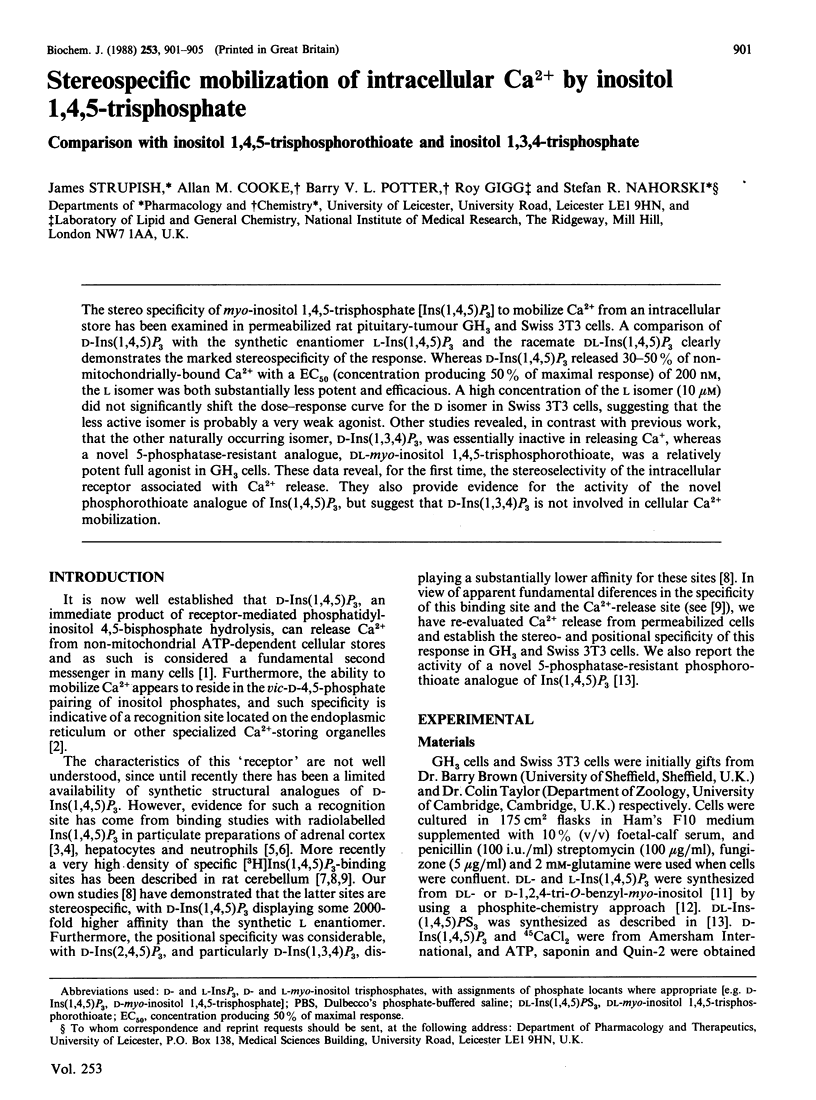
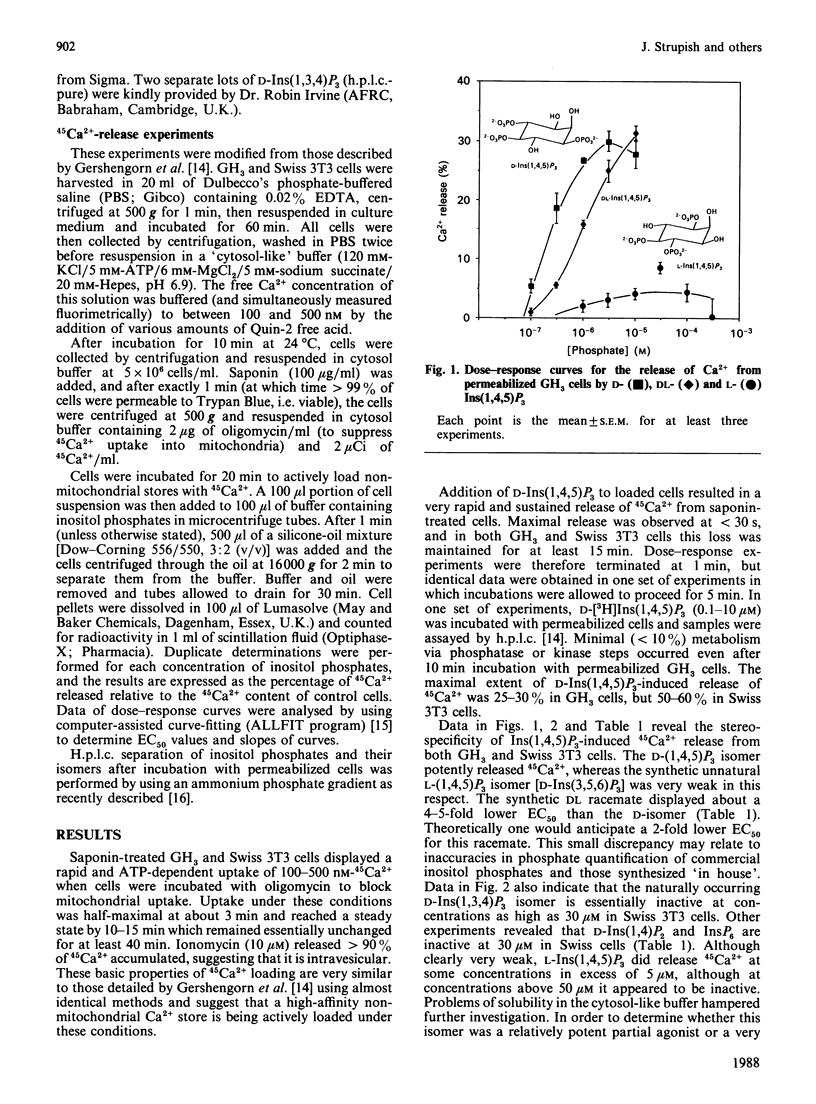
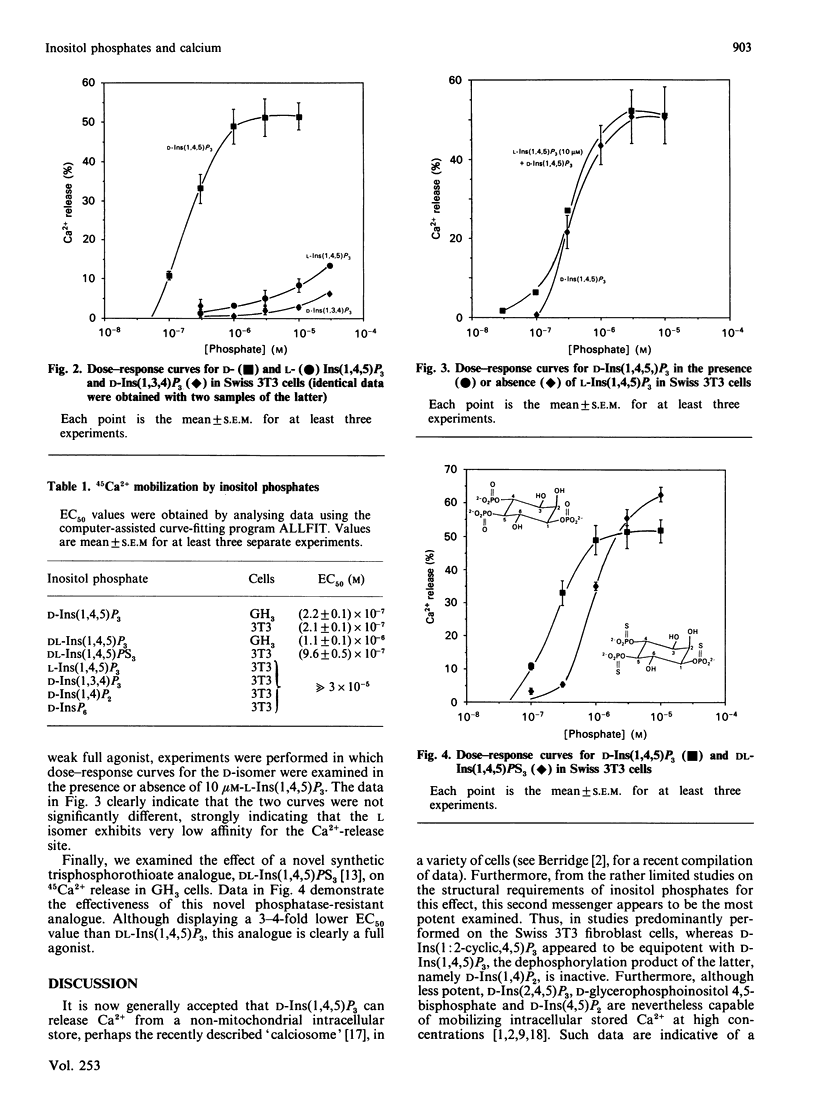
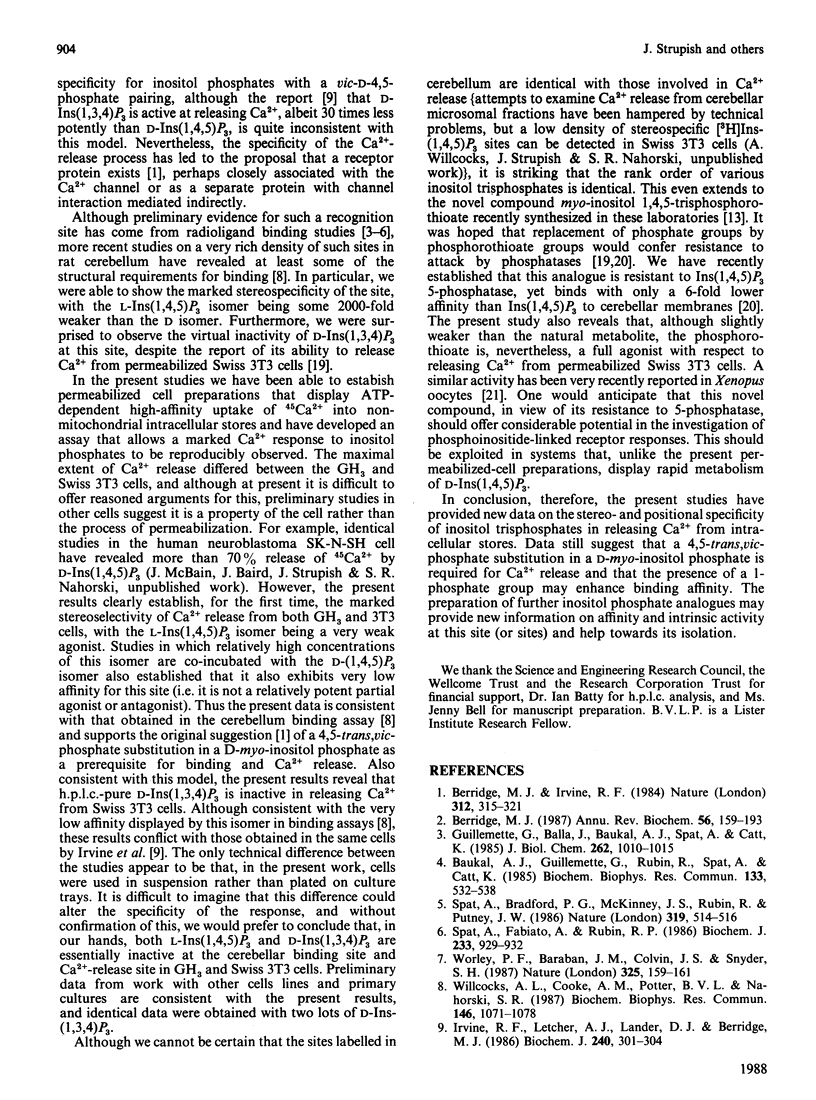
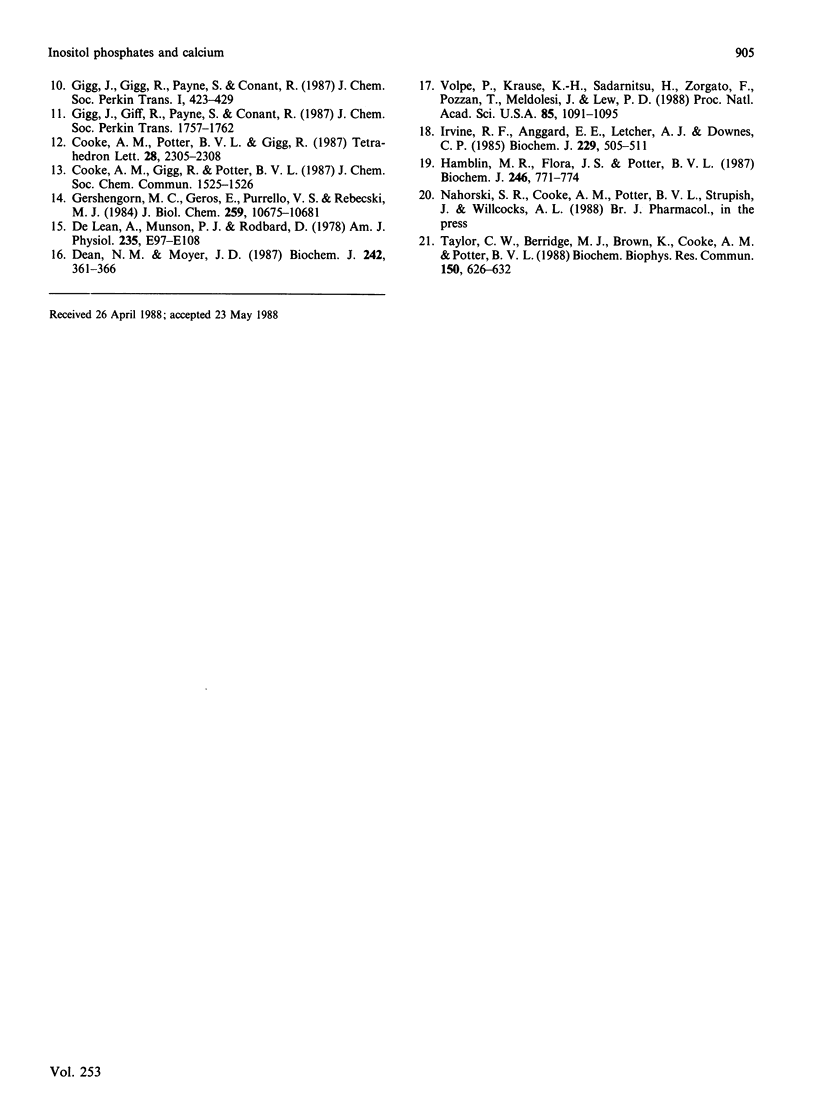
Selected References
These references are in PubMed. This may not be the complete list of references from this article.
- Baukal A. J., Guillemette G., Rubin R., Spät A., Catt K. J. Binding sites for inositol trisphosphate in the bovine adrenal cortex. Biochem Biophys Res Commun. 1985 Dec 17;133(2):532–538. doi: 10.1016/0006-291x(85)90939-8. [DOI] [PubMed] [Google Scholar]
- Berridge M. J. Inositol trisphosphate and diacylglycerol: two interacting second messengers. Annu Rev Biochem. 1987;56:159–193. doi: 10.1146/annurev.bi.56.070187.001111. [DOI] [PubMed] [Google Scholar]
- Berridge M. J., Irvine R. F. Inositol trisphosphate, a novel second messenger in cellular signal transduction. Nature. 1984 Nov 22;312(5992):315–321. doi: 10.1038/312315a0. [DOI] [PubMed] [Google Scholar]
- DeLean A., Munson P. J., Rodbard D. Simultaneous analysis of families of sigmoidal curves: application to bioassay, radioligand assay, and physiological dose-response curves. Am J Physiol. 1978 Aug;235(2):E97–102. doi: 10.1152/ajpendo.1978.235.2.E97. [DOI] [PubMed] [Google Scholar]
- Dean N. M., Moyer J. D. Separation of multiple isomers of inositol phosphates formed in GH3 cells. Biochem J. 1987 Mar 1;242(2):361–366. doi: 10.1042/bj2420361. [DOI] [PMC free article] [PubMed] [Google Scholar]
- Gershengorn M. C., Geras E., Purrello V. S., Rebecchi M. J. Inositol trisphosphate mediates thyrotropin-releasing hormone mobilization of nonmitochondrial calcium in rat mammotropic pituitary cells. J Biol Chem. 1984 Sep 10;259(17):10675–10681. [PubMed] [Google Scholar]
- Guillemette G., Balla T., Baukal A. J., Spät A., Catt K. J. Intracellular receptors for inositol 1,4,5-trisphosphate in angiotensin II target tissues. J Biol Chem. 1987 Jan 25;262(3):1010–1015. [PubMed] [Google Scholar]
- Hamblin M. R., Flora J. S., Potter B. V. myo-Inositol phosphorothioates, phosphatase-resistant analogues of myo-inositol phosphates. Synthesis of DL-myo-inositol 1,4-bisphosphate and DL-myo-inositol 1,4-bisphosphorothioate. Biochem J. 1987 Sep 15;246(3):771–774. doi: 10.1042/bj2460771. [DOI] [PMC free article] [PubMed] [Google Scholar]
- Irvine R. F., Anggård E. E., Letcher A. J., Downes C. P. Metabolism of inositol 1,4,5-trisphosphate and inositol 1,3,4-trisphosphate in rat parotid glands. Biochem J. 1985 Jul 15;229(2):505–511. doi: 10.1042/bj2290505. [DOI] [PMC free article] [PubMed] [Google Scholar]
- Irvine R. F., Letcher A. J., Lander D. J., Berridge M. J. Specificity of inositol phosphate-stimulated Ca2+ mobilization from Swiss-mouse 3T3 cells. Biochem J. 1986 Nov 15;240(1):301–304. doi: 10.1042/bj2400301. [DOI] [PMC free article] [PubMed] [Google Scholar]
- Spät A., Bradford P. G., McKinney J. S., Rubin R. P., Putney J. W., Jr A saturable receptor for 32P-inositol-1,4,5-triphosphate in hepatocytes and neutrophils. Nature. 1986 Feb 6;319(6053):514–516. doi: 10.1038/319514a0. [DOI] [PubMed] [Google Scholar]
- Spät A., Fabiato A., Rubin R. P. Binding of inositol trisphosphate by a liver microsomal fraction. Biochem J. 1986 Feb 1;233(3):929–932. doi: 10.1042/bj2330929. [DOI] [PMC free article] [PubMed] [Google Scholar]
- Taylor C. W., Berridge M. J., Brown K. D., Cooke A. M., Potter B. V. DL-myo-inositol 1,4,5-trisphosphorothioate mobilizes intracellular calcium in Swiss 3T3 cells and Xenopus oocytes. Biochem Biophys Res Commun. 1988 Jan 29;150(2):626–632. doi: 10.1016/0006-291x(88)90438-x. [DOI] [PubMed] [Google Scholar]
- Volpe P., Krause K. H., Hashimoto S., Zorzato F., Pozzan T., Meldolesi J., Lew D. P. "Calciosome," a cytoplasmic organelle: the inositol 1,4,5-trisphosphate-sensitive Ca2+ store of nonmuscle cells? Proc Natl Acad Sci U S A. 1988 Feb;85(4):1091–1095. doi: 10.1073/pnas.85.4.1091. [DOI] [PMC free article] [PubMed] [Google Scholar]
- Willcocks A. L., Cooke A. M., Potter B. V., Nahorski S. R. Stereospecific recognition sites for [3H]inositol(1,4,5)-triphosphate in particulate preparations of rat cerebellum. Biochem Biophys Res Commun. 1987 Aug 14;146(3):1071–1078. doi: 10.1016/0006-291x(87)90756-x. [DOI] [PubMed] [Google Scholar]
- Worley P. F., Baraban J. M., Colvin J. S., Snyder S. H. Inositol trisphosphate receptor localization in brain: variable stoichiometry with protein kinase C. Nature. 1987 Jan 8;325(7000):159–161. doi: 10.1038/325159a0. [DOI] [PubMed] [Google Scholar]


